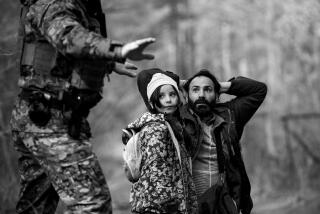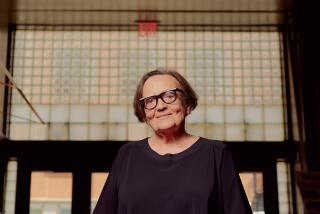Meticulous details add up to Holocaust trivia in ‘Zone’
- Share via
There is little doubt that everyone involved in the making of “The Grey Zone,” a film about Jewish prisoners forced to man the gas chambers and crematoriums at Auschwitz, had the best of intentions when they embarked on this project. That holds especially true for writer and director Tim Blake Nelson, whose struggle to shoot, then secure distribution for the film reads like an exemplary tale of heroic independence in the face of base commercial indifference. The problem is that good intentions are as useless as artistic ambitions at Auschwitz, where neither art nor sentimentality has a place. It isn’t just that there’s something unsettling about a film that aestheticizes a crematorium; it’s that there’s something trivializing about the very effort.
Based on a play by Nelson first staged in 1996 and named after a chapter in Primo Levi’s memoir “The Drowned and the Saved,” “The Grey Zone” unfolds just as a squad of these Jewish prisoners, called the Sonderkommandos, is planning a revolt. As the day and night wear on, the men argue and plan the uprising against a backdrop of their horrifying daily labor -- escorting prisoners, other Jews mainly, into the gas chambers, then disposing of their corpses in the ovens and fiery pits. Levi called the Sonderkommandos “National Socialism’s most demonic crime.” They were men, he wrote, in whom “the tradition of hostility toward the stranger makes of them monsters of asociality and insensitivity.”
You get glimpses of these monsters in “The Grey Zone,” as when a Sonderkommando fatally beats an arrival to the sounds of the man’s screaming wife. The scene is horrible to watch and yet nowhere horrible enough. None of it is. Steven Spielberg’s decision to show water rather than Zyklon B flowing from shower heads in “Schindler’s List” may have been misguided, but you can understand why he opted not to re-create the agonies of the gas chambers: It would have been unbearable. The crimes committed at Auschwitz were unspeakable; at their worst, they were beyond what entertainment cinema, which demands realism but not necessarily truth, can show us.
Nelson nonetheless tries by re-creating the camp’s violence with excruciating detail. He shows us men, women and children in transport trains. (Still, the train cars are too roomy; unlike the real deportees, the actors can sit, stand and breathe freely.) He shows us the gas chambers, the ovens, the pits and the truckloads of ash being hauled off for burial. He shows the gas chambers being scrubbed clean of smears of blood and excrement, then whitewashed so the horror can begin again. It’s almost as if Nelson believed that if he could re-create the mechanism of death, he could crack its code, get at its meaning, even refute Levi’s famous observation -- spoken to him by a camp guard -- that there was no “why” at Auschwitz. But Nelson can’t, which is why sections of “The Grey Zone” resemble nothing so much as a ghastly process film.
This material meticulousness stands in perverse contrast to the screenplay and the performances, both of which seem to belong to some other film. Nelson’s dialogue, pumped up with stilted, theatrical cadences, may have worked fine on a New York City stage, but sounds ridiculous coming out of the mouths of the likes of David Arquette, Steve Buscemi, Mira Sorvino, Natascha Lyonne, Daniel Benzali and Harvey Keitel. (The actors playing Nazis speak in German-accented English; most of the rest of the principals converse in their normal voices, a surreal touch in the case of the Brooklyn-born Buscemi.) The cast looks persuasively miserable but only David Chandler, as a Sonderkommando, and, in the film’s best performance, Allan Corduner as a Jewish doctor working for Dr. Mengele, transcend the abject text.
It helps that Corduner and Chandler have unfamiliar faces. Sorvino and the other name actors may have secured the film’s finances, but they are a distraction: There isn’t a moment when she’s on screen that you’re not aware that Sorvino’s sepulchral cheekbones are as much an actor’s conceit as the pitch of her character’s cries. In this regard it’s inconceivable that Nelson didn’t consider the ramifications of casting Arquette in the lead role, not simply because the actor has yet to demonstrate he has the depth the part demands, but because he’s best known for the “Scream” franchise. “The Grey Zone” is filled with such miscalculation, including a subplot concerning a young girl who survives the gas and becomes the spur to a palpably false debate, the stuff of high school ethics, as to whether one life is worth hundreds.
Nelson has said that he was inspired to tell the story of “The Grey Zone” after learning about the Sonderkommandos, realizing, as he put it, that “I was an able-bodied man in his 30s. That could have been me. So it became very personal.” The desire to personalize the Holocaust is reasonable but it is a hazardous point of departure for a story as difficult and immense as that of the Nazi extermination camps, in part because personalizing that story is to risk trading understanding for empathy, even where none is warranted. Nelson either can’t bear or simply refuses to create characters as monstrous as Levi described. But just as there is no need for drama at Auschwitz, in which everyday life was an epic of suffering, neither is there a place for sentimentalism.
*
‘The Grey Zone’
MPAA rating: R for strong Holocaust violence, nudity and language. Times guidelines: extremely intense, disturbing images of torture and death, plus graphic nudity; this film is strictly for adults.
Released by Lions Gate Films. Writer and director Tim Blake Nelson. Based in part on a memoir by Miklos Nyiszli. Producers Pamela Koffler, Christine Vachon, Tim Blake Nelson, Avi Lerner and Danny Lerner. Director of photography Russell Lee Fine. Editors Tim Blake Nelson and Michelle Botticelli. Production designer Maria Djurkovic. Costume designer Marina Draghici. Music Jeff Danna. Running time: 1 hour, 38 minutes.
David Arquette...Hoffman
Daniel Benzali...Schlermer
Allan Corduner...Nyiszli
Steve Buscemi...Abramowics
Harvey Keitel...Muhsfeldt
Henry Stram...Mengele
Mira Sorvino...Dina
Natasha Lyonne...Rosa
More to Read
Only good movies
Get the Indie Focus newsletter, Mark Olsen's weekly guide to the world of cinema.
You may occasionally receive promotional content from the Los Angeles Times.










